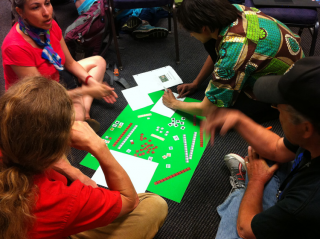Festival2012/Submit/Paper-prototype socially responsive games with verbs
- Title of session: Paper-prototype socially responsive games with verbs
- Your name and affiliation: Matteo Menapace, baddeo.com / milocreative.com
- Session format: Design Challenge
What will your session or activity allow people to make, learn or do?
In this session you will work in teams to remix classic videogames in response to a social issue or a real world scenario, using paper-prototyping techniques.
Inspired by Grow-A-Game, this session will allow you to prototype a game starting with something we are all familiar with: verbs! Whether it is running or collecting, shooting or trading, games are driven by verbs. We will look at classic games in terms of verbs and explore how these verbs express messages and values. Then we will modify these games, changing the verbs so they express our own messages and values.
Games are useful to explore complex issues and chains of reactions because they allow players to simulate real life situations, where all aspects of the game function according to set rules. These rules echo the values and ideologies of the game designers (in real life, the policy makers). These ideologies manifest themselves in games through the actions (hence verbs) that players can or cannot take, and through the goals that determine success or failure (game over).
Playful simulation is a powerful way of analysing and engaging in debate of a social issue, because it allows you to explore different roles and forces you to take decisions, which bring consequences and responsibilities. You are not just observing an issue at a distance, you are instead immersing yourself in that issue and forming a first-hand opinion.
This is a paper-prototyping session, so you don't need a computer or programming skills to take part! It may help if you bring along your coloured markers and scissors.
How do you see that working?
- We will start with a short introduction on the verbs of videogames: what can players do or not do in games, how can they interact with enemies, other players or props, and why this is important
- Form groups of 4-5 people
- Assign each group a randomly chosen videogame and a randomly chosen social issue
- Provide each group with:
- a videogame cheat sheet (with the game's description and questions to help your brainstorm)
- a collection of sprites ripped from the assigned game, printed on paper and pre-cut
- a problem card describing a social issue and a scenario that explores how the issue can manifests itself (with contextual information and questions to help your brainstorm)
- Ask each group to break down the game mechanics into verbs and think about the implicit or explicit messages that these verbs may entail and the consequences they would have in a real world scenario
- Prototype a modified version of your game using verbs from your issue, and messages that represent your views of such issue
- Present your new game to the other groups
The session will last about two hours, followed by the groups presentation (5 minutes each).
How will you deal with 5, 15, 50 participants?
Participants will form teams of ideally 4-5 people.
Team sizes will depend on the number of participants and the number of games/issues available (5 or 6, but participants could propose their own).
So in an ideal scenario we would have 5 groups of 5 people (25 people in total), but it won't be a problem to enlarge groups so that we can scale up to 50 people or more. We could also have a couple of emergency games and issues to be used in case of participants flooding.
How long within your session before someone else can teach this?
About 7 minutes and 23 seconds..
Once groups are formed and games/issues are assigned, they can use the questions on the cheatsheets and problem cards to guide their games analysis and brainstorm. These materials, together with the pre-cut games sprites, will scaffold the group activity and encourage participants to reason in visual and spatial terms, in a collaborative way: they will be able to rearrange elements as if they were working on a jigsaw puzzle.
What do you see as outcomes after the festival?
This will be your party bag:
- develop a critical thinking approach to entertainment commodities
- practice team work in a playfully structured activity
- develop a methodology that can be applied to game design and user experience design in general (using constraints to channel your creative response)
- leave with a prototyped concept, which you can develop further (digitally as a video game or physically as a board game)
- organize similar hack-a-game sessions, independently, in the future
